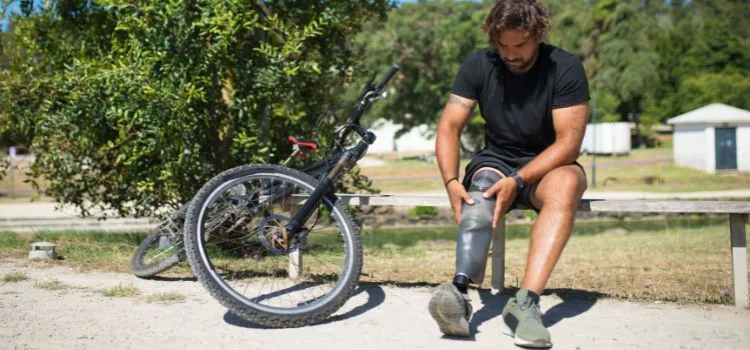Mountain Biking Injury Statistics

Downhill biking is one of the favorite cycling disciplines of mountain bikers. This game requires good skills and a fit body for mountain biking like an expert. If we talk about experts here, the new riders who just entered this sport need practice as there are risks. It can be a concern if they need to gain expertise in mountain biking and they start biking. Remembering potential dangers, you should read the mountain biking injury statistics first, then practice.
Table of Contents
Short Answer
As downhills are the dangerous part of this sport, many mountain bikers with bad luck or no experience can fall into the situation of injuries. At the same time, they are compared to other mountain biking causing minor injuries that can be cured in a while. But with no expertise, if you are going to do mountain bike, we let you know that it can also cause significant injuries, which can put your body on the body for the whole life or a long time. According to reports, the expert players of mountain bikes are found with a 0.6% risk rate in a year and one injury per 1000 h of biking.
If you ask those who have taken up downhill riding, many will express how thrilling the surge of adrenaline is and the sense of achievement that comes from overcoming a challenging stretch of terrain. However, navigating obstacles such as roots, rocks, and jumps comes with inherent risks, which makes the sport captivating.
Risks and Dangers of Downhill Mountain Biking:

Every human adopts sports because they play a vital role in human health and are fun. But there are also risks and injuries associated with these types of sports. However, they can be minor injuries to major. So let’s start with the topic.
At Which Rate Do Mountain Bikers Often Get Injuries?
A British Journal of sports medicine highlights a very concrete number. It says about the overall calculated injury rate of MTB. The downhill mountain biker’s rates were 16.8 injuries per 1k h exposure.
According to mountain biking injury statistics, mountain bikers experience one injury for every 59.5 hours spent riding, or in other words, one damage per 10 days of riding. However, the number of errors or accidents is likely greater since only some mishaps result in an injury. This rate doesn’t belong to the damage to the tissues of bikers.
Which Body Parts Are Most Likely To Be Injured In Downhill MTB?

One of the more significant research about mountain biking injuries paid attention to this question. They calculated the type of injuries and their frequency rate in 2017 and 2018. It was about the racing season of EWS, in which bikers race on many downhills within the time per race day observed. The studies only observe ten race events over 2000 racers from different countries.
- The most injured body parts were the shoulder and clavicle area, which was a 13% rate.
- Hands – 9%.
- Head – 9%.
- Lower legs – 8%.
- Elbows – 7,4%.
- Knees (6,9%).
- Forearms (5,9%).
- Fingers (5,9%).
- Back (4,3%).
- Neck (2,1%), which is rare.
From these facts, we can draw several conclusions:
The body parts most frequently injured in a crash are essential to protect. Some injury rates would be higher if not for mandatory safety equipment like helmets and knee pads. While shoulder and elbow pads are not commonly worn in Enduro racing, they are still worth considering due to the risks involved.
Certain body areas, such as the clavicle, hands, forearms, and fingers, cannot be effectively protected. However, even with low statistical probabilities, the risk of severe injury to specific body parts, such as the neck, should not be taken lightly, as the consequences can be life-altering.
Which type of injuries are the most common in MTB?
If we talk about the common injuries, with mountain biking injury statistics, the rates are high because these are very common to occur in mountain biking.
Soft tissue & skin injuries
The first ones we are talking about are soft tissues and skin injuries. These injuries are most likely to occur in downhill biking. The first thing to be injured can be soft tissues can skin. They can appear asphalt surfaces, hard and rough surfaces. Didn’t you expect that? Yes, they can happen. When you fall, or your body hits a bike’s part, these little injuries can occur even with protective gear rubbing.
How can they be treated?
Most of these types of injuries are treated by first-aid kit. These injuries are minor but have a high rate the common injuries in MTB.
Head Trauma
While we cannot ignore head injuries because they cannot be easily treated depending on the injury situation, the head is the body’s most valuable part, so it cannot be healed instantly. In addition to head injuries, the most injuries which are more likely to occur are concussions. The reports stated that this head injury is highly in danger. The other head injuries can be considered minor but also need good treatment.
Repetitive head injuries can have significant and enduring adverse effects. Traumatic brain injuries (TBI) are still not entirely understood, and long-term treatment can be challenging.
Fractures in Bone
As downhills have rocks, mud, and wood, it increases the chances of bone fractures. If we see, fractures are one of the common injuries, but sometimes they can be like hell at a time of recovery because they can also take weeks to months to cure. With a fractured bone, you cannot do mountain bike can also apart you from many valuable events.
What to do
While rolling can help reduce the impact force during a crash, it may not always be feasible when things spiral out of control. According to mountain biking injury statistics, the first thing you should keep in mind is not riding out of your comfort zone and out of control because it increases the chances of fractures.
Joint injuries
While racing downhill, shoulders play a role in balancing the bike handle efficiently. This injury occurs commonly during downhill riding. Let us tell you that this injury is high risk and also takes much time to recover. The shoulder’s primary work is to handle the bike well when riding and keep a balance.
How to be safe
You can only be safe if you wear the protective vest sleeves, as no separate shoulder pad can help you. We suggest you wear them even in high degrees during MTB.
Following the shoulders, wrists, ankles, and elbows are the most vulnerable joints to injury. While knee injuries are common, most riders protect their knees with proper gear. Although wrist and ankle braces are available, they are typically worn after an injury has occurred rather than as a preventative measure, as they can significantly impede mobility.
The Risks of Mountain Biking

As with any outdoor activity or sport, mountain biking has risks. Here are the three main types of risks associated with mountain biking:
- Risk of injury
Falling off the bike is the primary cause of injuries. This can occur when riders push beyond their skill level or need to pay adequate attention to the trail.
- Difficulty in controlling body temperature
Extreme weather conditions and long rides in hot or cold weather can make it challenging to regulate body temperature.
- Mountain bike failure
Lack of maintenance or inadequate bike maintenance is the primary reason for bike failure.
Of these risks, the primary cause of injury is falling off the bike, which accounts for approximately 70% of cases. The contributing factors for each of the three types of risks are presented in the table below.
FAQs
What is the most common mountain bike injury?
Shoulder injuries are the most common, followed by wrists, ankles, and elbows.
Is mountain biking high-risk?
Yes, Mountain biking carries a moderate to high risk of injury due to falls and collisions.
What are the potential injuries from mountain biking?
Potential injuries include shoulder, wrist, ankle, and elbow injuries and head and neck injuries.
How many people get injured from mountain biking?
Approximately one injury per 59.5 hours of riding or one damage per 10 days of riding.
Conclusion
In conclusion, mountain biking is a thrilling and adventurous sport with its own risks. Understanding the potential injuries that riders face is essential to minimizing those risks. The mountain biking injury statistics show that shoulder injuries are the most common among mountain bikers, followed by injuries to wrists, ankles, and elbows.
Head and neck injuries pose a significant risk, and repetitive head injuries can have long-lasting adverse effects. Despite these risks, mandatory safety gear like helmets and knee pads can help mitigate damages. Proper bike maintenance and staying within one’s skill level can also reduce the risk of injury. Overall, mountain biking can be a safe and exhilarating activity with appropriate precautions.
